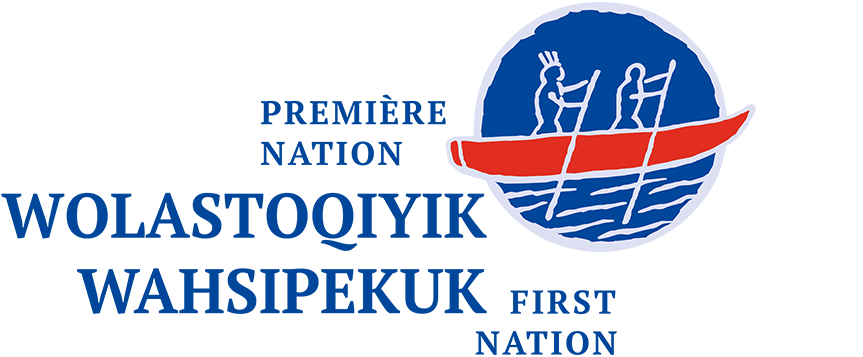

Home / Lessons / Level 1 / 7. Animate-Inanimate: Property of Words
In this lesson, you will learn the basics needed to properly classify words as animate or inanimate in the wolastoqey language. You will also learn how to ask where objects are located and explain where they are situated using words that express spatial positions.
n Wolastoqey, the gender of words is expressed in terms of animate and inanimate (unlike French, for example, where we talk about feminine and masculine gender).
The animate or inanimate gender is a property of words and not of the objects themselves. Thus, it is the word ‘spoon’ that is animate and not the spoon itself.
The animate or inanimate gender is assigned to nouns. Nouns that refer to people or animals are often animate. Nouns that refer to objects, ideas, or concepts can be either animate or inanimate.
The animate or inanimate gender is also assigned to verbs. This may seem surprising because verbs in French do not inherently have gender; they agree with the subject, which is feminine or masculine. In Wolastoqey, verbs are animate or inanimate, among other factors, depending on the animate or inanimate nature of their subject.
There is no absolute logic that distinguishes animate or inanimate gender. The same goes for masculine and feminine gender in French; there is no logic to why a ‘fauteuil’ (armchair) is masculine and a ‘chaise’ (chair) is feminine!
There are some tricks that can help memorize gender. Although the assignment of animate or inanimate gender does not follow precise rules, trends can be identified. For example, nouns that refer to people (with a soul, a spirit), animals, or trees are usually animate, as well as objects that can contain a liquid (such as a bowl, a spoon, a bottle, or a pen).
To determine if a word is animate or inanimate, the best resource is a dictionary; usually, the gender is indicated alongside entries. Currently, the only online resource that contains this information for Wolastoqey is the Peskotomuhkati-Wolastoqey Language Portal (https://pmportal.org).
Pronouns used with words also change depending on animate or inanimate gender. Here’s a helpful reminder:
| - Key concept - | ||
|---|---|---|
| Inanimate (I) | Nit nit keq nit nit  |
It is what it is |
Keq yut?  |
What’s that? | |
| Animate (A) | Not not wen not not  |
He is who he is |
Wen wot?  |
Who is this? | |
The animate and inanimate gender also influences sentence structures. Here are some examples:
| Inanimate | Tama ote malsanikuwam ?  |
Where is the store? |
| Animate (person or animal) | Tama iyu Ahtuwen ?  |
Where is Anthony? |
| Animate (object) | Tama opu emqan ?  |
Where is the spoon? |
The pronouns used with the words change depending on whether they are animate or inanimate.
| - Key concept - | |
|---|---|
| Not | Wot |
| Animate pronoun meaning «this one» | Animate pronoun meaning «that one» |
| Nit | |
| Inanimate pronoun | |
Question: Wen not ? / Who is this person, this animal? (A)
Wen wot ? / ho is that person, that animal? (A)
Keq nit ? / What is it? (I)
Answers: Not not wen not not. / He is who he is. (A)
Nit nit keq nit nit. / That’s what it is. (I)
| - Key concept - | |||
|---|---|---|---|
| Animate | (person or animal) | iyu | Verb meaning "to be somewhere" |
| (object) | opu | Verb meaning "to be somewhere" | |
| Inanimé | ote | Verb meaning "to be somewhere" | |
Nihkaniw  |
In front of |
Asit  |
Behind |
Tehsaqiw  |
On top of |
Neqiw  |
Underneath |
Opomew  |
On the side |
Emehkew  |
Below or bottom |
Qonusqiw  |
At the top |
Milawiw  |
Down the street |
Nulomok  |
Up the street |
Qihiw  |
Near or next to |
Lamiw  |
Inside |
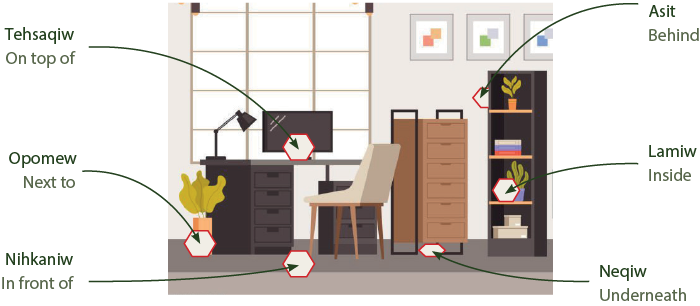
Question 1: Tama iyu Piyel ?  / Where is Peter? (Peter, animate, person = iyu)
/ Where is Peter? (Peter, animate, person = iyu)
Answer 1: Piyel iyu milawiw.  / Peter is down the street.
/ Peter is down the street.
Question 2: Tama ote pocetes ?  / Where is the potato? (Potato, inanimate = ote)
/ Where is the potato? (Potato, inanimate = ote)
Answer 2: Pocetes ote neqiw tuwihputik.  / The potato is underneath the table.
/ The potato is underneath the table.
Question 3: Tama opu emqan ?  / Where is the spoon? (Spoon, animate, object = opu)
/ Where is the spoon? (Spoon, animate, object = opu)
Answer 3: Emqan opu opomew wikuwamok.  / The spoon is next to the house.
/ The spoon is next to the house.
Determine if the object represented in the photo is animate or inanimate in order to ask the appropriate question: « Keq yut ? » or « Wen wot ? » Then answer the question by naming the object.
If necessary, check the Peskotomuhkati-Wolastoqey online portal: https://pmportal.org/



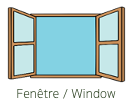



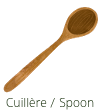




Based on the image presented, choose which verb should be used to ask the question.
Tip: Use the Peskotomuhkati-Wolastoqey online portal: https://pmportal.org/ to check the animate or inanimate gender of the elements in the image.
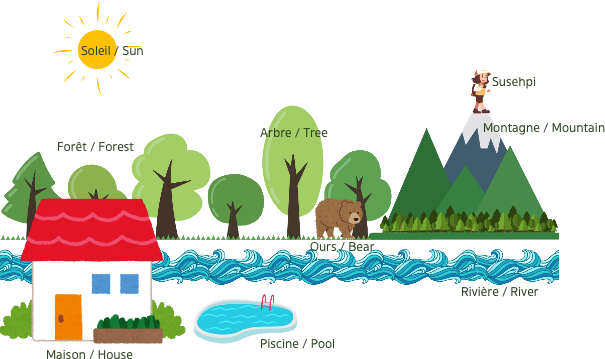
Find the Wolastoqey words that correspond to each of the elements on the list.
How it works: Click on the first letter of the word, then on the last to validate a word.
Words can overlap and go in these directions: → ↘ ↓.
Additional information for exercises solutions may appear in the Appendix of the PDF document.